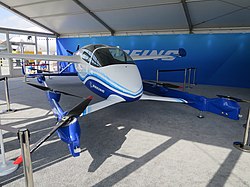Boeing Passenger Air Vehicle
| Boeing Passenger Air Vehicle | |
|---|---|

|
|
| Type: | Electric aircraft , for vertical takeoff and landing as an air taxi |
| Design country: |
United States |
| Manufacturer: | |
| First flight: |
3rd May 2019 |
| Commissioning: |
planned for 2024 |
The Boeing Passenger Air Vehicle (PAV) is an electrically powered aircraft that can fly autonomously and take off and land vertically . It has been developed by Boeing's subsidiary Aurora Flight Sciences in Manassas, Virginia , since 2017 .
development
Aurora carried out the first flight tests with a 1:10 model and then with a 1: 4 scale concept aircraft. Within a year the development up to a flying prototype could be carried out. The Boeing PAV's first hover took place on January 22, 2019. The next development steps include the transition from hovering to level flight with aerodynamic lift through the wings.
The prototype has two pairs of blades connected to the short, large-diameter cabin in the center and a propeller with a horizontal axis. The upper pair of wings is equipped with winglets . The lower one holds a bar on the right and lower left, which is also connected to the cabin by struts. There are four motors with propellers on each of these rails. In order to obtain a more stable position in the direction of flight, the fixed axes of the propellers are not vertical, but rather have a small angle to each side. The first outwards, the second in the direction of the central axis and so on. The tail unit is a combination of an additional wing and two vertical stabilizers on the outside of each side that resemble large winglets.
The design as a flight helicopter with a combination of rotors and blades is more energy efficient than a pure multicopter. This is particularly important as long as the electricity storage system is not yet sufficiently developed that a long flight duration is possible.
Incidents
On June 4, 2019, the PAV crashed during its 5th test flight. Boeing officials declined to provide details of the crash.
During the flight test, the engineers noticed some brief data failures and unusual engine speeds and decided to end the flight. The pilot gave the command for automatic landing. After a brief descent, the aircraft engines idled and the aircraft crashed onto the runway. It was severely damaged. The review of the recorded data showed that vibrations occurred that briefly exceeded the threshold for the jerk logic. It is used to detect ground contact (in addition to squat switches). The aircraft went into ground mode and turned off the engines.
Technical specifications
| Parameter | PAV |
|---|---|
| crew | self-steering (optionally 1 pilot) |
| Passengers | 2-4 |
| length | 9.14 m |
| width | 8.53 m |
| payload | 225 kg |
| Empty mass | 565 kg |
| Max. Takeoff mass | 800 kg |
| Cruising speed | 180 km / h |
| Range | 80 km |
| Engines | 9 electric motors with propellers, one with a horizontal axis, 8 with an approximately vertical axis 8 × 75 kW |
See also
Web links
Individual evidence
- ↑ Photo of the e-VTOL concept aircraft. In: evtol.news. Retrieved November 30, 2019 .
- ↑ Volker K. Thomalla : Boeing's passenger drone has completed its maiden flight. In: aerobuzz.de. aerobuzz, January 24, 2019, accessed November 30, 2019 .
- ↑ Jerry Siebenmark: Boeing's Autonomous Prototype Crashes. In: ainonline.com. June 12, 2019, accessed March 18, 2020 .
- ^ Aviation Accident Final Report. In: ntsb.gov. April 6, 2019, accessed March 18, 2020 .
- ↑ Boeing's experimental autonomous aircraft completes its first test flight. In: theverge.com. theverge, accessed November 30, 2019 .
- ↑ Carrie Hampel: Boeing VTOL takes test flight as flying taxi. In: electrive.com. electrive, January 23, 2019, accessed November 30, 2019 .
- ^ Aurora Flight Sciences Pegasus PAV Full-Scale PAV Specifications. In: evtol.news. The Electric VTOL News, accessed March 4, 2020 .